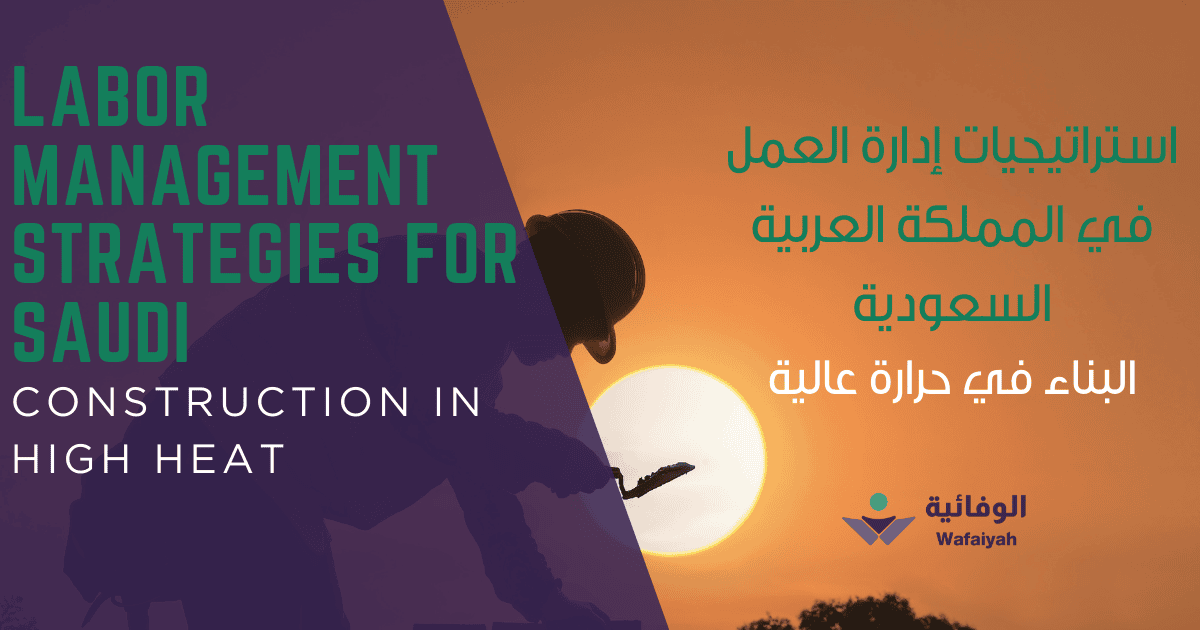Saudi Arabia’s construction industry faces major challenges due to extreme heat, with temperatures often rising above 40–50°C. This harsh weather puts workers at serious risk, making labor management extremely important. Good management protects worker health, boosts productivity, and ensures project success. Companies like Wafaiyah understand that careful planning is key to balancing worker safety, legal rules, and smooth operations. Without the right strategies, projects can face delays, accidents, and heavy fines. A strong focus on safety helps workers stay healthy and motivated, even in tough conditions. Managing labor wisely is not just smart, it’s essential for lasting success.
The severe Saudi Arabian temperatures pose major risks to people who build structures. You can get dehydrated, develop strokes, feel exhausted and harm your brain when working in extreme temperatures. This also gets unsafe for focused tasks that need physical strength. The construction site poses greater hazards because employees have to handle intensive physical activities daily. Accidents happen frequently and the project completion takes longer when heat safety conditions remain unprotected. The Saudi labor rules forbid workers to work from noon to three in the summer afternoon to keep them safe. These measures prevent workers from being overheated during that specific time period. Companies should use advanced technology plus better planning and workforce support to maintain project progress and keep the employees well protected. The changes will help Saudi construction achieve a safer and more effective future.
Early Morning and Night Shifts
Planning building work for cooler times, like 4 AM–11 AM and 5 PM–10 PM, will greatly reduce the amount of time spent in the high temperature. Companies protect their workers from the hottest parts of the day by starting early or staying late. This helps them stay healthy, keep up their energy, and boost total productivity.
Staggered Breaks
Instead of one long break, giving workers many small breaks let them cool down and rehydrate more often. Spanning breaks reduces the risk of getting sick from the heat and keeps workers awake. Hence, this helps them keep making steady progress throughout the shift, especially when it’s really hot.
Shift Rotation
By shifting workers around to different jobs and areas, they are not exposed to direct high temperature for long periods of time. In this way, companies can protect worker health and keep them from getting too tired. It also helps to keep safety and job performance at a higher level on building sites by moving teams between shaded, indoor, and lighter work zones.
Smart Scheduling Technology
With smart scheduling tools and weather apps, managers can change work schedules based on what the day’s report says. Technology helps people plan their jobs around the hottest times of the day, which lowers the risk of accidents. It’s also easier to deal with sudden changes in the weather and keep workers safe and productive when you have real-time information.
Planning Hydration and Nutrition Programs
To keep workers from getting too dehydrated in the high temperature, water and electrolyte drinks should be set up all over the building site. Giving them light, energy-dense meals instead of big, fatty ones keeps their energy up without putting too much stress on their digestive system. During shifts, all workers should have to take breaks to drink water, so they drink enough all the time, not just when they’re thirsty. It’s also important to teach workers how to spot the early signs of illness and dehydration. This helps keep major emergencies from happening. Companies can keep their workers healthier, more focused, and better prepared for tough situations by giving them the right nutrition and water programs.
Need of Health Monitoring and Emergency Readiness
To keep workers safe in very hot weather, there should be on-site medical teams ready to help right away in an emergency. Having paramedics or first responders on site cuts down on reaction times and makes sure that people get care quickly if they need it. Wearable health tech, like smart bands, can constantly check your heart rate, body temperature, and level of water. This can let your boss know about any risks before they get worse. Before each shift, workers should get a daily health check that includes measuring their blood pressure and heart rate to make sure they are fit to work in hot circumstances. There must be emergency action plans in place and they must be practiced often. This makes sure that everyone on the team knows what to do if someone gets heat stroke or is dehydrated. This lets the team act quickly and effectively in situations that could be life-threatening. These cautious steps help keep the workplace safer, which reduces health risks and boosts the chances of project success.
Requirement of Worker Education and Cultural Sensitivity
They need to be taught of stress, the symptoms and the best way to avoid getting stress by programs. Workers should know the risks that are involved and also how to be safe when working in a dangerous heat stroke situation. There should be more than one language in which communication happens. All employees should be able to understand the rules using Arabic, Urdu, Bengali, Tagalog and so on. Additionally, it is important to stick to another world’s cultures. For instance, Ramadan and other religious holidays are counted when designing a training program. This also includes providing ease to workers who are fasting and giving them right breaks at the right times.
Legal Compliance and Ethical Responsibility
It is essential that the Saudi Labor Ministry rules are followed. For instance; workers must not be compelled to work within the middle of the day and must have places to rest in the shade. These rules are to protect workers from the very high temperature and prevent illnesses from it. However, companies that take steps beyond minimal compliance in implementing advanced management systems frequently have a higher retention, higher productivity, and a safer work environment. The law is just a minimal basis for ethical labor-management, and it is also good for a company’s public image. To build trust in customers, government agencies and the community at large, companies place worker safety and well-being first. This leads to long-term success.
Conclusion
Managing labor in high-heat environments is not just about compliance—it’s a key element of smart leadership. Companies like Wafaiyah understand that prioritizing worker safety through innovative strategies boosts productivity and ensures long-term success. Looking ahead, advancements in technology and management will further improve labor conditions. By adopting heat-smart strategies now, companies will thrive in Saudi Arabia’s booming construction industry, setting a strong foundation for growth and sustainability. It’s time to invest in the future of construction safety and efficiency.
Frequently Asked Questions
What are the best labor management strategies in Saudi Arabia’s heat?
Scheduling shifts during cooler hours, providing hydration stations, and using protective gear are key strategies for managing labor in extreme high temperatures.
How can companies ensure worker safety in high temperatures?
Frequent hydration breaks, rotating shifts, and providing cooling vests or accessories help keep workers safe in extreme high temperatures.
Are there any legal regulations for construction work in Saudi Arabia’s heat?
Yes, Saudi labor laws mandate a work ban from 12 PM to 3 PM during summer to protect workers from heat-related risks.
How does hydration help in heat management for workers?
Proper hydration prevents dehydration and stress, keeping workers’ energy levels up and reducing the risk of stroke.

